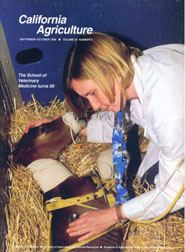All Issues

The School of Veterinary Medicine turns 50
Cover:
Veterinary student examines a prematurely born foal in the intensive care unit of the Veterinary Medical Teaching Hospital. The Large Animal Clinic's Equine Neonatal ICU treats foals with conditions such as infections or gastrointestinal problems, and those that develop complications following a difficult birth... Photo by Debbie Aldridge
September-October 1998
Volume 52, Number 5
Volume 52, Number 5





